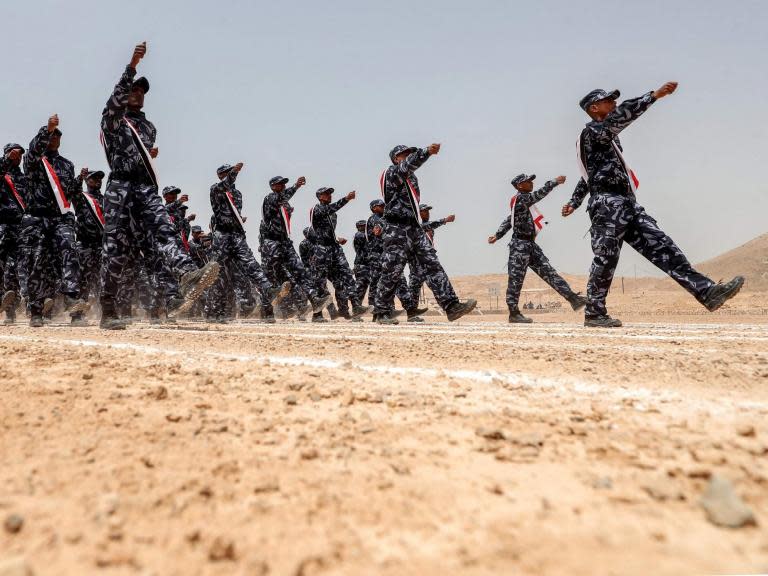How the conflict in Yemen could lead to the return of al-Qaeda
There is a joke circulating among southern Yemenis, that every four years there is a war in south of the country. And right now they are bracing for another one.
Most would retort that Yemen is very clearly already at war. Thousands of Yemeni have been killed since 2015 when the Shia Houthi rebel group swept control of the country from Yemen’s president, Abedrabbo Mansour Hadi.
Saudi Arabia and the UAE launched a bombing campaign shortly after to reinstate the recognised government, fearing a Houthi-controlled Yemen was part of the expansionist plans of Iran.
Three years on, the devastating conflict, which grinds on in the north, has bought the country to its knees.
Three-quarters of the population – or 22 million people – rely on aid to survive. The estimated death toll veers from 10,000 dead to five times that much. The country has been on the verge of famine for a year.
It’s also brought some bad PR for the Gulf coalition (that is incidentally a major beneficiary of UK arms) over the soaring civilian casualties. Most recently, 40 children were killed when a Saudi airstrike hit a school bus, according to the Red Cross.
But one group at least is winning out of this war: the southern separatists, who have been imbued with significant power since they joined forces with the Gulf coalition. And for them, bashing the Houthis is just the precursor to the true fight.
Below the surface, a dangerous civil war within an already devastating civil war is brewing – and its roots are older than unified Yemen its self.
For the next conflict in Yemen will be the war for independence and a return to divided country.
Adam Baron, a former resident of Yemen and visiting fellow at ECFR who joined me in Yemen, said its arguable that the “tensions are among the highest they’ve ever been”.
“The ways things currently stand there’s a real limit to how far things can get kicked down the road,” he said.
Yemen was only unified in 1990. Civil war broke out four years later, which the south ultimately lost. Separatists in both South Yemen and in the UAE, where many Yemenis are now based, have spoken of “being occupied” by the north when they lost that war.
“It’s an occupation we still feel today,” one said to me quietly.
This may not seem important issue to the west, lost in the mesmerising mess of Yemen: the Gulf’s most impoverished and least understood country.
But it is within the fault lines of fighting in Yemen that insurgencies tend to flourish.
During the start of the 2015 conflict in Yemen, al-Qaeda in the Arabian Peninsula (AQAP), arguably al-Qaeda’s most pernicious branch, conquered a 700km stretch of coastline. A second civil war germinating out of a pre-existing one will only cultivate more fertile land for AQAP to return.
It could also set two Middle East power houses, and UK allies – UAE and Saudi Arabia – against each other with potentially devasting consequences.
From my brief stay hopping between Emirati bases in Yemen, it was clear, unlike Saudis, that the UAE had unfurled a serious military infrastructure across South Yemen. Through their proxies – in the form of tens of thousands of Yemeni soldiers they have trained – they control most of the air strips, bases and sea ports along Yemen’s strategically placed southern coast. For the five-day stay, I did not see a single Saudi officer.
Despite publicly insisting they want a united Yemen, the UAE has been accused of siding with the separatists by arming and funding them, because of their hatred of both the Houthis and the Muslim Brotherhood, Abu Dhabi’s arch enemy.
The ill-will between UAE and President Hadi is no secret. In January, both sides came to blows in Aden, the de facto capital of the anti-Houthi alliance. In a barrage of grad missiles and tank fire, forces loyal to Hadi battled the separatist Southern Transitional Council and its forces the Security Belt, which was formed, financed and armed by the UAE.
The STC is part of the anti-Houthi coalition and headed up by Aidarous al-Zubaidi, the one-time governor of Aden who was sacked by Hadi. From the outside it looked like Saudi-backed forces were at war with Emirati ones.
Calm has largely been restored to Aden. Hadi, who hadn’t been back to Aden for over a year, was finally let back in June 2018. But the war-wounded city still feels tense.
At Aden international airport, I am introduced to a young man called Khalid al-Khali. Slightly shy to camera, he doesn’t cut the most imposing figure as he talks about studying law before the war with the Houthis broke out.
Dressed in fatigues, he explains he now mans a battalion, trained by the Emiratis, which guards (and so controls) the airport, Yemen’s main exit and entry point ever since the Gulf Coalition shut down Sanaa airport.
But over a quiet dinner in the UAE, Khalid and his brothers are described by Yemenis as powerful figures in the separatist movement. In one case the word “troublemaker” is used.
That he was chosen to man such a key airport is significant. Amr al-Beidh, who comes from separatist royalty (his father, Ali Salem al-Beidh, a prominent politician, was president of the short lived separate South Yemen in the 1990s) tells me the division of Yemen isn’t just inevitable but essential for the “stability of the region”.
“Without independence in the south there will always be a cycle of violence between the south and the north”, he said.
“International trade lines will be affected, the fight against al-Qaeda will be affected. We can’t build a civil state with the north. Reunification failed”.

 Yahoo News
Yahoo News 

